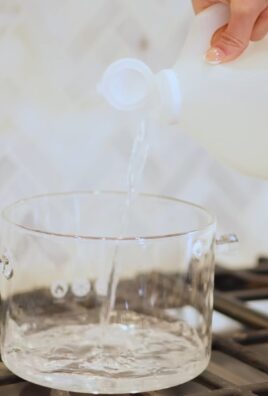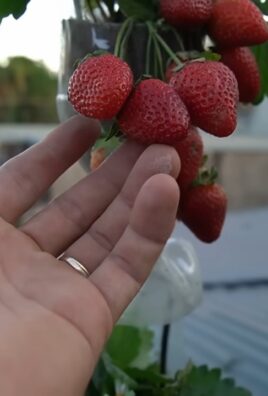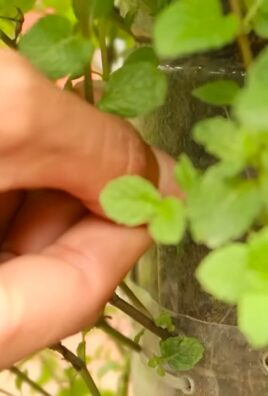Grow Brussels Sprouts in Containers: A Gardener’s Delight
Growing Brussels sprouts might seem daunting, conjuring images of vast fields and sprawling gardens. But what if I told you that you could enjoy the delicious, nutty flavor of these miniature cabbages right on your patio or balcony? That’s the beauty of growing Brussels sprouts in containers – it’s a surprisingly accessible and rewarding gardening project, perfect for even the smallest of spaces. This DIY guide will walk you through everything you need to know, from selecting the right container to harvesting your bountiful crop.
Historically, Brussels sprouts, a member of the Brassica family, have a rich history dating back centuries. While their exact origins are debated, they’ve been cultivated in Europe for hundreds of years, gradually making their way to other parts of the world. Today, they’re a beloved vegetable enjoyed in countless cuisines, and now, thanks to container gardening, they can be a part of your culinary adventures.
Why bother with growing Brussels sprouts in containers? Well, for starters, it’s incredibly convenient! No more battling weeds or contending with unpredictable soil conditions. Container gardening offers unparalleled control over your plants’ environment, allowing you to optimize their growth and yield. Plus, it’s a fantastic way to add a touch of green to your urban landscape, even if you lack a traditional garden. Whether you’re a seasoned gardener or a complete beginner, this guide will empower you to successfully grow your own delicious Brussels sprouts, no matter how limited your space.
So, let’s get started on this exciting journey of growing Brussels sprouts in containers and unlock the secrets to a thriving harvest right in your backyard (or balcony!).

Growing Brussels Sprouts in Containers: A Step-by-Step Guide
I love Brussels sprouts, but they can take up a lot of garden space. That’s why I decided to try growing them in containers! It’s surprisingly easy, and you can even do it on a balcony or patio. Here’s how I did it:
Choosing Your Containers and Location
- Container Size: Brussels sprouts need deep containers, at least 18 inches deep and 12 inches wide. The larger, the better! I used 20-gallon containers, which gave my plants plenty of room to grow their extensive root systems.
- Material: Choose a material that retains moisture but also allows for drainage. Plastic or terracotta pots both work well. I prefer plastic because it’s lighter and easier to move around.
- Drainage Holes: Ensure your containers have adequate drainage holes to prevent root rot. If they don’t, drill some yourself.
- Sunlight: Brussels sprouts need at least 6-8 hours of direct sunlight per day. Choose a sunny spot on your patio, balcony, or even a sunny windowsill (though this might require supplemental lighting).
- Accessibility: Consider the accessibility of your chosen location. You’ll need easy access to water and to harvest the sprouts.
Preparing the Soil and Planting
- Gather your supplies: You’ll need your chosen containers, high-quality potting mix (I recommend a mix specifically designed for vegetables), Brussels sprout seedlings (or seeds), and a watering can.
- Fill the containers: Fill your containers almost to the top with the potting mix. Leave about an inch of space at the top for watering.
- Prepare the seedlings: If using seedlings (which I recommend for easier growing), gently remove them from their original containers, being careful not to damage the roots. If starting from seeds, follow the seed packet instructions for planting depth and spacing.
- Plant the seedlings: Create a small hole in the potting mix for each seedling. Space them about 12-18 inches apart, depending on the variety. Gently place the seedlings in the holes and cover the roots with soil. Firm the soil gently around the base of each plant.
- Water thoroughly: After planting, water the seedlings deeply to settle the soil and help them establish their roots. Use a gentle stream of water to avoid disturbing the soil around the plants.
Ongoing Care and Maintenance
- Watering: Brussels sprouts need consistent moisture. Water regularly, especially during dry periods. Check the soil moisture by sticking your finger a couple of inches into the soil. If it feels dry, it’s time to water. Avoid overwatering, which can lead to root rot.
- Fertilizing: Feed your plants every 2-3 weeks with a balanced liquid fertilizer. Follow the instructions on the fertilizer packaging for the correct dilution rate. I use a slow-release fertilizer for convenience.
- Pest and Disease Control: Regularly inspect your plants for pests like aphids or cabbage worms. If you find any pests, treat them promptly with an appropriate insecticide or by hand-picking them off. Good air circulation can help prevent fungal diseases.
- Support (Optional): For larger varieties, you might need to provide support to prevent the plants from flopping over. You can use stakes or cages.
- Weeding: Regularly remove any weeds that may compete with your Brussels sprouts for nutrients and water.
Harvesting Your Brussels Sprouts
- Harvest Time: Brussels sprouts are typically ready for harvest in the fall, about 70-90 days after planting, depending on the variety. The sprouts should be firm and a deep green color.
- Harvesting Technique: Harvest individual sprouts by snapping them off the stalk. Don’t pull the entire stalk. Start harvesting from the bottom of the stalk and work your way up. This allows the upper sprouts to continue to grow.
- Storage: Store harvested Brussels sprouts in a refrigerator for up to a week. You can also freeze them for longer storage.
Troubleshooting Common Problems
Yellowing Leaves:
Yellowing leaves can indicate several issues, including nutrient deficiencies, overwatering, or underwatering. Check your watering schedule and consider adding fertilizer if needed.
Small Sprouts:
Small sprouts can result from insufficient sunlight, poor soil quality, or overcrowding. Ensure your plants receive adequate sunlight and use a high-quality potting mix. Consider thinning out the plants if they are overcrowded.
Pest Infestations:
Regularly inspect your plants for pests. Use appropriate pest control methods as needed. Consider using organic pest control options to protect beneficial insects.
Remember:
Growing Brussels sprouts in containers requires a bit more attention than growing them in the ground, but the rewards are well worth the effort. With proper care, you’ll be enjoying delicious, homegrown Brussels sprouts in no time!

Conclusion
So there you have it! Growing Brussels sprouts in containers is a surprisingly rewarding and manageable gardening project, even for those with limited space or gardening experience. This DIY trick offers a level of control and convenience that traditional garden plots simply can’t match. You’re in charge of the soil quality, sunlight exposure, and pest control, leading to healthier, more productive plants. The ability to move your containers as needed to optimize sun exposure or protect them from harsh weather is a game-changer. This method allows you to enjoy a bountiful harvest of delicious, homegrown Brussels sprouts, regardless of your gardening expertise or the size of your yard. The satisfaction of nurturing these plants from seed to harvest is unparalleled, and the taste of fresh, homegrown Brussels sprouts is a culinary experience you won’t soon forget. Don’t let the idea of growing your own vegetables intimidate you; this container gardening method makes it easier than you might think. Give it a try – you might just discover a new passion! Share your experiences and photos with us – we’d love to see your thriving Brussels sprout containers and hear about your harvest! We encourage you to experiment with different container sizes and varieties of Brussels sprouts to find what works best for you and your growing conditions. Remember, the key to success is consistent watering, proper fertilization, and a little bit of patience.
Suggested Variations and Tips for Growing Brussels Sprouts in Containers:
* Container Size and Material: While 5-gallon containers are a good starting point, you can experiment with larger containers for multiple plants or smaller containers for individual plants. Consider using materials like plastic, wood, or even repurposed containers, ensuring they have adequate drainage holes.
* Soil Selection: Use a high-quality potting mix that’s well-draining and rich in organic matter. Avoid using garden soil directly from your yard, as it can be too heavy and compact for container gardening.
* Sunlight Requirements: Brussels sprouts need at least 6-8 hours of direct sunlight per day. Choose a sunny location for your containers, or supplement with grow lights if necessary.
* Watering: Keep the soil consistently moist but not waterlogged. Water deeply and regularly, especially during hot and dry periods. Consider using a self-watering system for added convenience.
* Fertilization: Feed your Brussels sprouts regularly with a balanced fertilizer, following the package instructions. Organic fertilizers are a great option for promoting healthy growth.
* Pest and Disease Control: Monitor your plants regularly for pests and diseases. Take appropriate action if you notice any problems, such as using insecticidal soap or neem oil.
* Companion Planting: Consider companion planting with herbs like rosemary or thyme, which can help deter pests.
Frequently Asked Questions (FAQs)
What size containers are best for growing Brussels sprouts?
Five-gallon containers are a great starting point for growing Brussels sprouts in containers. However, you can use larger containers (10-15 gallons) to accommodate multiple plants or smaller containers (3-gallon) for individual plants. The key is to ensure the container is deep enough to accommodate the root system, which can grow quite extensive. Larger containers will generally result in larger plants and a higher yield.
What type of soil is best for growing Brussels sprouts in containers?
Use a well-draining potting mix that’s rich in organic matter. Avoid using garden soil directly from your yard, as it can be too heavy and compact for container gardening. A good quality potting mix specifically formulated for vegetables will provide the necessary nutrients and drainage. You can also amend your potting mix with compost or other organic matter to improve its fertility and water retention.
How much sunlight do Brussels sprouts need?
Brussels sprouts need at least 6-8 hours of direct sunlight per day to thrive. Choose a sunny location for your containers, or supplement with grow lights if necessary, especially during shorter days or in areas with limited sunlight. Insufficient sunlight can lead to poor growth and reduced yields.
How often should I water my Brussels sprouts in containers?
Keep the soil consistently moist but not waterlogged. Water deeply and regularly, especially during hot and dry periods. The frequency of watering will depend on factors such as temperature, humidity, and container size. Check the soil moisture regularly by sticking your finger a couple of inches into the soil. If the soil feels dry, it’s time to water. Consider using a self-watering system to maintain consistent moisture levels.
What kind of fertilizer should I use for Brussels sprouts?
Use a balanced fertilizer, following the package instructions. Organic fertilizers are a great option for promoting healthy growth and improving soil health. You can also use slow-release fertilizers to provide a consistent supply of nutrients throughout the growing season. Avoid over-fertilizing, as this can damage the plants.
When can I harvest my Brussels sprouts?
Brussels sprouts are typically ready for harvest in the fall, about 70-90 days after planting. The sprouts will be firm and tightly closed. Harvest the sprouts individually as they mature, starting from the bottom of the stalk and working your way up. Don’t harvest all the sprouts at once; leave some on the plant to continue growing.
What are some common problems when growing Brussels sprouts in containers?
Some common problems include pests (aphids, cabbage worms), diseases (downy mildew, clubroot), and nutrient deficiencies. Regularly inspect your plants for signs of pests or diseases and take appropriate action if necessary. Ensure your plants receive adequate sunlight, water, and nutrients to prevent nutrient deficiencies. Proper soil drainage is also crucial to prevent diseases. Choosing disease-resistant varieties can also help minimize problems.
Can I grow Brussels sprouts in containers in all climates?
While Brussels sprouts prefer cooler climates, you can successfully grow them in containers in various climates with proper care and attention to their needs. In warmer climates, consider planting in the fall or winter for optimal growth. In colder climates, you may need to provide protection from frost or harsh weather conditions. Using a container allows you to move the plants to a more sheltered location if needed. Consider using a cold frame or greenhouse to extend the growing season in colder climates. The key is to provide the right conditions for the plant to thrive. Remember to choose a variety suitable for your climate.




Leave a Comment